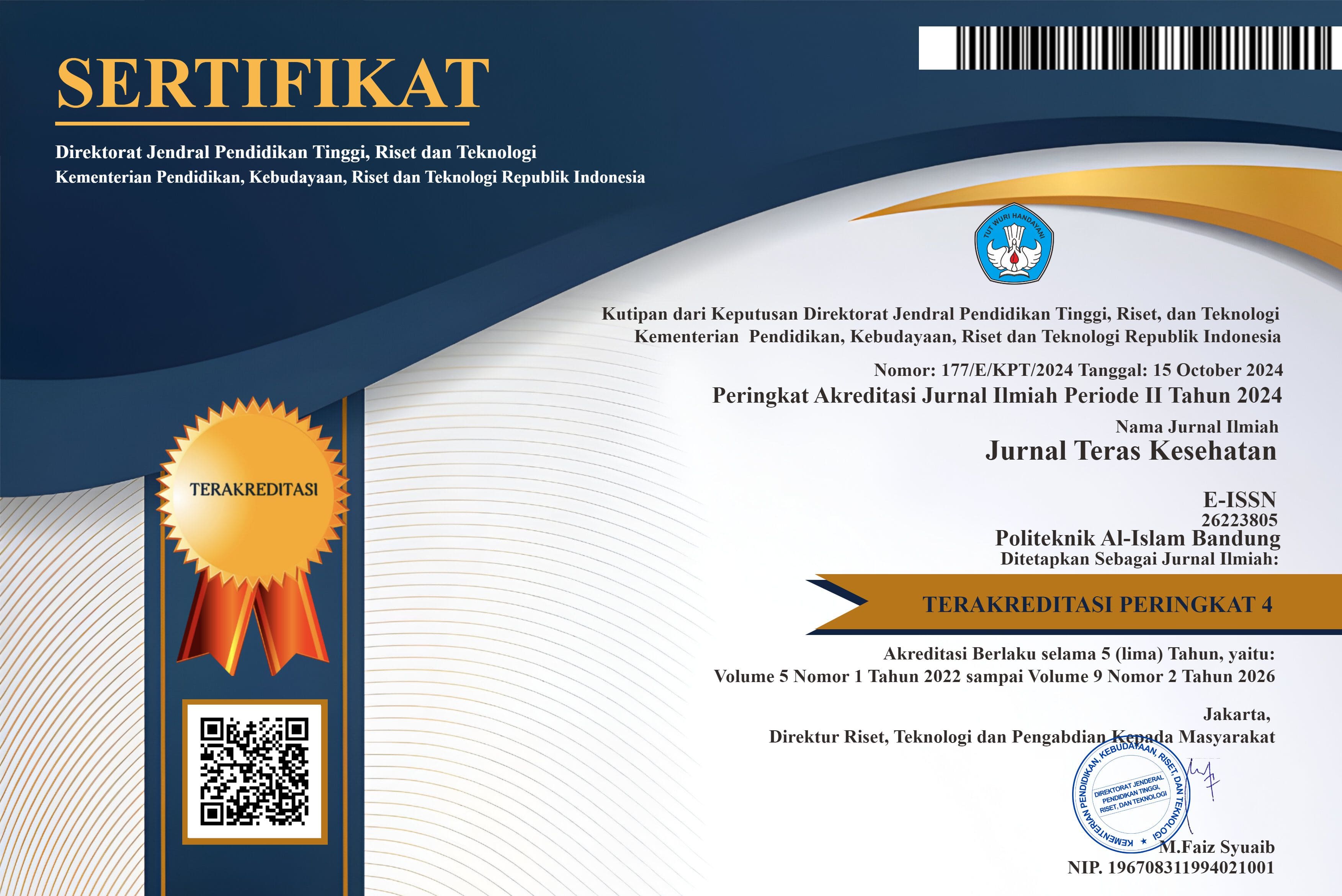REDUKSI DOSIS RADIASI PEMERIKSAAN FEMUR DENGAN BIOPLASTIK TIMBAL: PENDEKATAN CITRA DAN ANATOMI
RADIATION DOSE REDUCTION IN FEMUR EXAMINATION USING LEAD BIOPLASTICS: AN IMAGING AND ANATOMICAL APPROACH
DOI:
https://doi.org/10.38215/jtkes.v8i2.210Keywords:
Contrast to Noise Ratio, Femur, Gaussian High Pass Filter, Lead Bioplastic, Peak Signal to Noise RatioAbstract
X-ray radiation in the medical field offers substantial diagnostic benefits but also poses potential risks to both patients and medical personnel. This study aims to evaluate the effectiveness of bioplastic made from cassava starch and lead acetate as a radiation dose absorber in femur radiographic examinations. The examinations were conducted using Anteroposterior (AP) and Lateral projections with portrait and diagonal detector positions. Image processing utilized the Gaussian High Pass Filter (GHPF) method with cut-off frequencies of 5, 10, and 15 Hz. Image analysis was performed using Contrast to Noise Ratio (CNR) and Peak Signal to Noise Ratio (PSNR). The results indicated that the use of bioplastic reduced CNR and PSNR values compared to examinations without bioplastic, although the image quality remained within acceptable clinical limits. For instance, in the AP diagonal projection with a 5 Hz cut-off, the CNR value for the proximal femur was 22.86 (with bioplastic) versus 21.95 (without bioplastic), while the corresponding PSNR values were 11.1 and 11.6, respectively. Additionally, radiation dose attenuation was supported by increased Mean Squared Error (MSE) values, indicating effective shielding by the bioplastic. Cut-off frequencies of 5 and 10 yielded the best image quality in both conditions.
Downloads
References
Ayyubi, S. N., Purbasari, A., & Kusmiyati. (2022). The effect of composition on the mechanical properties of biodegradable plastic based on chitosan/cassava starch/PVA/crude glycerol: Optimization of the composition using Box Behnken Design. *Material Today: Proceedings, 63*, S78-S83. https://doi.org/10.1016/j.matpr.2022.01.294
Beaulah, V., Sridevi, P., & Ravali, K. S. (2024). Hindlimb skeletal structure of the green-winged macaw: An anatomical study. http://dx.doi.org/10.56557/UPJOZ/2024/v45i104042
Chen, G., Wu, Z., & Hen, Z. (2022). Scalable, strong, and water-stable wood-derived bioplastic. *Chemical Engineering Journal, 439*, 135680. https://doi.org/10.1016/j.cej.2022.135680
Edirisinghe, S., D Silva, D., & Dissanayake, H. (2024). Anatomical diversity in femur bones: Understanding the morphological variability for surgical and prosthetic applications. *International Journal of Morphology, 42*(1), 162–165. http://dx.doi.org/10.4067/S0717-95022024000100162
Hannachi, E., Slimani, Y., & Sayyed, M. I. (2022). Synthesis of lead oxide doped SmBa2Cu3Oy ceramic systems as efficient shields against γ radiations: Structure, radiation attenuating capacities, and optical features. *Ceramics International, 7*, 124. https://doi.org/10.1016/j.ceramint.2022.07.124
Hashemi, S. A., Karimipourfard, M., & Mousavi, S. M. (2022). Transparent sodium polytungstate polyoxometalate aquatic shields toward effective X-ray radiation protection: Alternative to lead glasses. *Materials Today Communications, 31*, 103822. https://doi.org/10.1016/j.mtcomm.2022.103822
Oglat, A. A. (2020). Studying the radiation absorption and scattering of gamma rays by using different absorbers. *Radiation Physics and Chemistry, 172*, 108810. https://doi.org/10.1016/j.radphyschem.2020.109072
Septiano, A. F., Maulana, I., & Susilo. (2023). Fabrikasi dan karakterisasi bioplastik timbal sebagai bahan alternatif proteksi radiasi sinar-X. *Jupeten, 3*(2), 46–51. https://doi.org/10.53862/jupeten.v3i2.008
Septiano, A. F., Sutanto, H., & Susilo. (2020). Fabrication and analysis of radiation dose for elastic lead polyester composites as a glass coating. *Journal of Physics: Conference Series, 1567*(4), 042089. https://doi.org/10.1088/1742-6596/1567/4/042089
Setiawati, E., Anam, C., Widyasari, W., & Dougherty, G. (2023). The quantitative effect of noise and object diameter on low-contrast detectability of AAPM CT performance phantom images. Atom Indonesia, 49(1), 61–66. https://doi.org/10.55981/aij.2023.1228
Umeh, C. D., Agwu, K. K., & Okoye, C. M. I. (2021). Characterization of the radiation shielding properties of fired lead sample for X-ray shielding applications. *Progress in Nuclear Energy, 137*, 103765. https://doi.org/10.1016/j.pnucene.2021.103765
Welborn, D., & Lockwood, P. (2022). Lead-rubber shielding effect on radiation dose to the gonads from a bilateral hand X-ray examination. Radiography, 28, 360–365. https://doi.org/10.1016/j.radi.2021.12.013
Wu, J., Che, Y., Zhang, Y., et al. (2024). Global, regional, and national trends of femur fracture and machine learning prediction: Comprehensive findings and questions from global burden of disease 1990–2019. *Journal of Orthopaedic Translation, 46*, 52. https://doi.org/10.1016/j.jot.2024.03.002
Yusoff, N. H., Pal, K., & Narayanan, T. (2021). Recent trends on bioplastics synthesis and characterizations: Polylactic acid (PLA) incorporated with tapioca starch for packaging applications. *Journal of Molecular Structure, 1232*, 129954. https://doi.org/10.1016/j.molstruc.2021.129954
Zhang, B., Zhang, Y., Wang, B., He, X., Zhang, F., & Zhang, X. (2024). Denoising swin transformer and perceptual peak signal-to-noise ratio for low-dose CT image denoising. *Measurement, 227*, 114303. https://doi.org/10.1016/j.measurement.2024.114303

Downloads
Published
Issue
Section
License
Copyright (c) 2025 Jurnal Teras Kesehatan

This work is licensed under a Creative Commons Attribution-ShareAlike 4.0 International License.
Authors who publish articles in Jurnal Teras Kesehatan agree to the following terms:
- Authors retain copyright of the article and grant the journal right of first publication with the work simultaneously licensed under a CC-BY-SA or The Creative Commons Attribution–ShareAlike License.
- Authors are able to enter into separate, additional contractual arrangements for the non-exclusive distribution of the journal's published version of the work (e.g., post it to an institutional repository or publish it in a book), with an acknowledgment of its initial publication in this journal.
Authors are permitted and encouraged to post their work online (e.g., in institutional repositories or on their website) prior to and during the submission process, as it can lead to productive exchanges, as well as earlier and greater citation of published work (See The Effect of Open Access)








